Coding for Kids: A Guide for Parents (2025) | CodeYoung
To be or not to be? To be able to answer such questions precisely brings so much…. Stress! And of course, by the title, you might have already guessed it; in today’s piece, we will discuss everything coding for kids. For parents seeking a trusted coding school for kids, this will help you explore the benefits and opportunities coding provides for young learners.
Before discussing the how's and whys, let's examine some compelling stats highlighting the benefits of coding for kids.
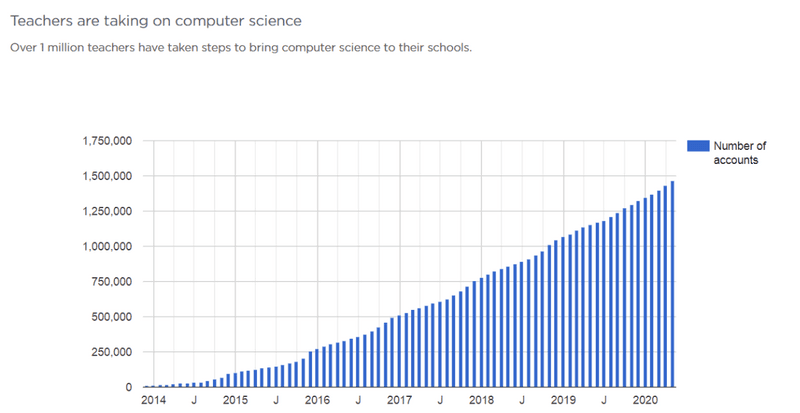
This is a Code.org statistic about teachers trying to introduce or level up computer science in their schools. Look at that rise! Don’t you want to be a part of something so revolutionary, especially when it can pave the way for a future career in coding?
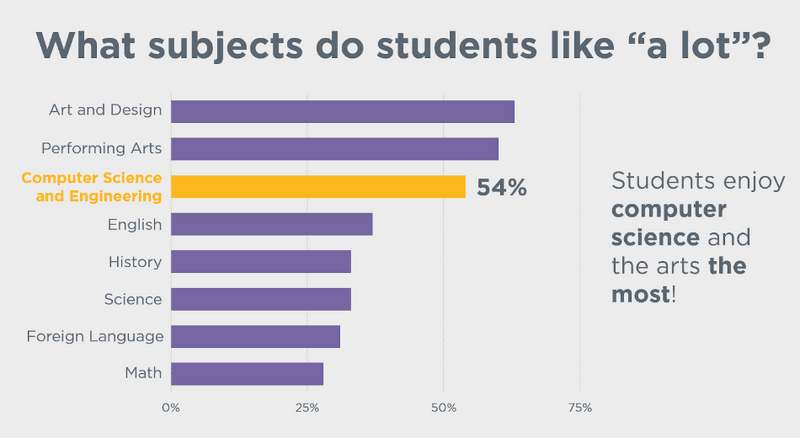
The above Code.org survey shows that 54 percent of students enjoy computer science. Don’t believe me, believe the statistics. Also, another great thing about learning to code is that you can do it anywhere.
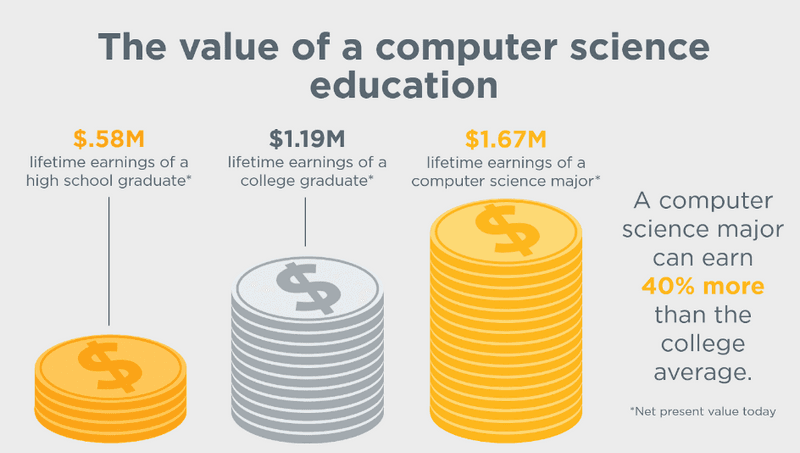
A survey conducted by Hour of Code (a Code.org campaign) shows the value of a computer science education, which is 40 percent more than the college average. This should be reason enough for parents to start their kids’ basic coding for beginners journey ASAP!
After consuming so much data and statistics, I think it’s time for the real deal. Let us begin our voyage to the ultimate guide to basic coding for beginners, starting with the first question.
What is coding for kids?
But, first what is coding? The process of communicating a set of instructions with machines and enabling them to respond according to it is called coding.
Now, think of it in a course structure where children learn to establish the above understanding of coding, therefore it is called coding for kids.
So, what’s the difference between coding and coding for kids?
The difference is in the way coding is taught. Therefore, we call it coding for kids because there are special requirements when you teach kids coding.
As of today, there are so many opportunities and so many options to choose from. And as a parent, you always want the best for your children. Have a look at our website to know more.
Coding knows no boundaries, just like kids. Try to expand their knowledge from a very young age. That takes us to our second question.
Remember the phrase- the earlier the better.
Exactly!
The world is changing rapidly, and so are technology and the education industry. Therefore, the future generation must be well prepared to keep up with these changes.
Children can begin learning to code as young as 5-6 years old. It means that parents don’t have to worry about the “safe age” for learning to code.
Kids are very impressionable and as a parent, you should leverage it to its fullest. That is why you have to choose wisely on what kind of activities should they be involved in. The fact the coding is a safe and secure activity should give you absolute peace of mind and let the child learn in their safe space.
Additionally, kids who learn to code from a very young age are believed to have a better grasp of the 21st century’s most important skills like teamwork, problem-solving, and creativity to name a few.
To know more, give The Top 21st Century Skills For Kids a read.
What are the benefits of Coding for kids?
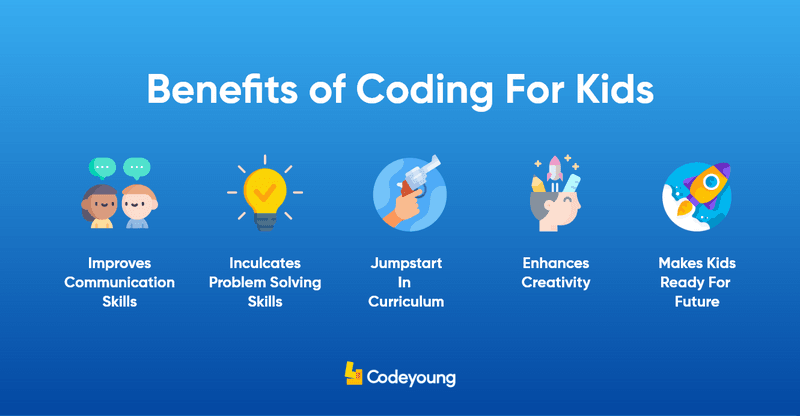
There are endless benefits of coding for kids. But here are a few of them to make you feel that you have made a great decision by choosing to code for kids. When children learn to code, they gain exposure to programming languages that can pave the way for a future career in coding.
- Increases EQ (emotional intelligence or emotional quotient) because of the practice of observation during coding.
- Better decision-making because of the use of accurate logic during coding.
- Coding challenges kids to solve complex problems and generate desired results.
- Adds to digital literacy. Coding has real-life applications which is why the government has included it as a standardized factor of development.
- Improves pre-existing academic knowledge.
- Expands critical thinking. Due to coding, a kid is exposed to think in a non-linear way.
- Builds persistence. Learning to code takes time and therefore the child has to keep going till the end which helps them to build their persistence.
Must-reads to know more:
- Coding For Kids: 5 Benefits of learning coding at a young age
- How can coding improve the logical ability of kids?
What are different types of programming languages?
There are different types of programming languages but those programming languages are classified into two major groups of programming.
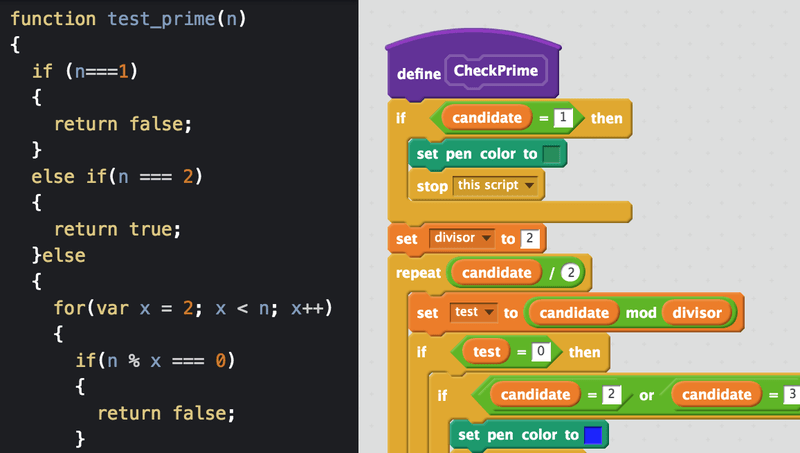
Text-based programming languages: Codes written in plain text format are called text-based programming. Professional programmers and experts in high-level programming mostly use it.
Visual-based programming or block-based programming languages: By the looks of it, this type of coding is visually more appealing than the previous example.
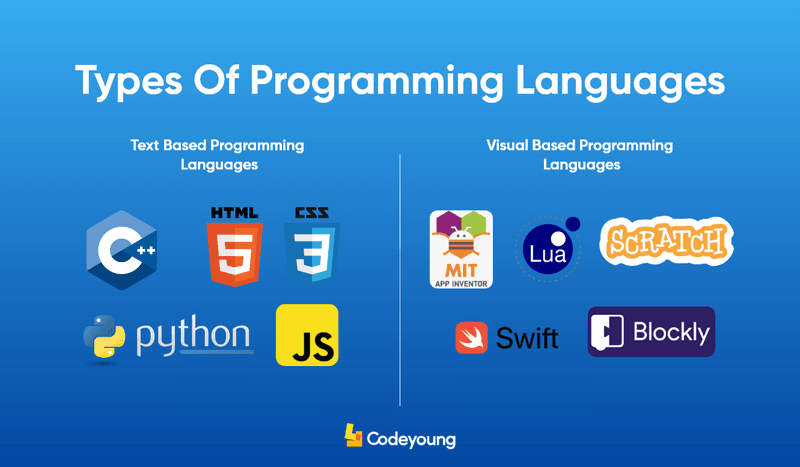
Because we are dealing with coding for kids, it is preferable to start with basic coding for beginners through visual-based programming due to its readability, ease of use, and the extent of technological advancement. Some of the popular programming languages are:
Some of the popular programming languages are:
- Python programming
- C++
- Scratch programming
- Lua
- JavaScript
- HTML
- CSS
- Blockly
Must-reads to know more:
How Does One Choose Coding Languages According to Age?
Here is the real deal, even though certain programming languages are catered towards particular age groups, you don’t have to stick to that convention.
‘Sky's the limit.’
With that in mind let me help you on how to choose which programming languages to choose according to age.
As we already know, there are two kinds of programming. Block-based programming is geared towards the lower or younger age groups because it uses both visuals and text.
Grade 1 - 2 ( Age range: 4 and higher)
- Scratch programming: One of the most popular programming languages made for kids to learn to code. Simple to use and the interface is specially designed for kids to understand visually rather than just the text instructions. Very widely used among the primary school-going kids.
Grade 3 - 5 ( Age range: 8 and higher)
- MIT App Inventor: Another popular pick accompanied with colorful visuals for easy understanding of the app development especially for mobile applications.
Grade 6 - 8 ( Age range: 12 and higher)
Web Development: An all-rounder programming language when it comes to building anything on the internet. It comprises of front end and back end meaning the things that you see when you visit a website. It is recommended for those who are interested in building a website.
Java & App Development: The old but mighty Java is one of the most popular programming languages and is still used for basic level programming to beyond. And the new addition is Application development which has been doing rounds for quite some time. It is very popular and recommended for those who want to pursue application-based programming.
Grade 9 and beyond (Age range: 14 and higher)
- Python: The coming of age programming language that serves the highest purposes of the coding world. It is used in most of the leading ventures of machine learning, data science, and artificial intelligence.
Must-read to know more:
What are the different career paths for kids who code?
From the introduction, we have already established that coding has one of the brightest career prospects for now and in the future.
But, let us do a little deep dive into each one of them.
Let’s go!
1) Python Developer
BrainStation states that a Python Developer is responsible for coding, designing, deploying, and debugging development projects, typically on the server side (or back end). A Python Developer often collaborates closely with data collection and analytics to create useful answers to questions and provide valuable insight.
Skills required and preferred:
- The Logical Thinking Ability
- A Deep Understanding of Core Python
- Good Grasp on Object Relational Mapper
- The comprehensive skill set of DS and ML
- Should be well acquainted with Web Framework
2) Web Developer
Web developers are responsible for designing and developing websites and website applications. Using a variety of programming languages and web technologies, web developers manage site functionality, implement application features, and integrate security measures.
Skills required and preferred:
- JavaScript
- HTML
- CSS (Cascading Style Sheets)
- Testing and Debugging
- Back-end basics of Web Development
- Web-designing
3) App Developer
CareerKarma states that an application developer works with a user experience (UX) designer to ensure the design aligns with the user's needs. Together, they create mockups for the app, and the developer must also coordinate with business leaders regarding launch strategies. Learning to code is essential in this process, especially for kids interested in a career in coding. Early exposure to coding for kids helps them grasp the fundamentals of programming languages while boosting critical thinking and problem-solving skills. The benefits of coding for kids go beyond technical knowledge—they also develop teamwork and communication skills as they engage in collaborative efforts, like coordinating with business leaders. By starting early, kids can better prepare for a future in the tech industry.
Skills required and preferred:
- Java and XML
- Understanding of development cycle
- Mobile Design Paradigm
- Node.js development
- Android Software Development Kit (SDK)
4) Game Developer
According to Wikipedia, a game developer can range from one person who undertakes all tasks to a large business with employee responsibilities split between individual disciplines, such as programming, design, art, testing, etc. Most game development companies have video game publisher’s financial and usually marketing support. Self-funded developers are known as independent or indie developers and usually make indie games.
Skills required and preferred:
- 3D Studio Max
- C++
- Java
- C
5) Data Scientists
Data scientists are big data wranglers, gathering and analyzing large sets of structured and unstructured data. Data scientists are analytical experts who utilize their skills in coding, technology and social science to find trends and manage data. They use industry knowledge, contextual understanding, skepticism of existing assumptions – to uncover solutions to business challenges.
Skills required and preferred:
- Data warehousing and structures
- Data Mining, Cleaning, and Munging
- Data Visualization and Reporting
- Cloud Tools
6) Machine Learning Engineer
Definition by Search Enterprise AI, a machine learning engineer focuses on researching, building, and designing self-running artificial intelligence (AI) systems to automate predictive models. Machine learning engineers design and create AI algorithms capable of learning and making predictions that define machine learning.
Skills required and preferred:
- Understanding of ML frameworks
- Understanding of Deep Learning
- Python
- SQL - Database
- R programming
What are the best ways to teach coding to kids?
Some of the coherent ways to teach the kids how to go about coding are:
- Use time management strategies to help kids to be organized with their tasks.
- Incorporate coding games to make the learning more fun and enjoyable rather than making it sound like a chore.
- Show real results, don’t just ask kids to imagine things.
- Every kid learns differently at a different pace, so don’t rush.
- Take expert help if needed. Let the professionals handle the important things.
- Ease them into coding. Start with something relevant and easily consumable.
- Talk coding terminologies to kids. That way it makes it exciting for them and gives a sense of accomplishment even in the initial stages.
Must-read to know more:
How to enhance coding skills in kids?
Enhancing the skill of coding is subjective. But, we believe that there are a few general practices that can help the execution better. Some of the ways by which kids can improve their coding skills:
- Practicing the Basics : Coding for beginners - Fundamental skills of any field are a must. To become a master in any skill, you should first master the basics.
- Take part in challenges and hackathons.
- Develop a project by yourself (mistakes are OK!)
- Take up interesting courses relating to your interest fields
- Join a community of like-minded people
- Follow other coders work and take inspiration from them
- Doubts are good. As a parent, encourage your child to ask questions.
- Read and iterate. Look for the things that you can learn from the previously published works.
As a student ask yourself these questions- What are they doing differently? Why are they doing it that way? What outcomes are they providing?
Best resources to learn coding for kids
There are innumerable coding sources and so much information can get overwhelming.
Don’t worry, we all have been there.
That’s we have curated a list that serves the right purpose for all your resources queries.
Websites:
- Code.org
- Codecademy
- Coursera
- Udacity
- Khan Academy
- Codeyoung
Some Amazing Books:
- Hello World! Computer Programming for Kids and Other Beginners by Warren Sande and Carter Sande
- Build Your Own Website: A Comic Guide to HTML, CSS, and WordPress by Nate Cooper and Illustrated by Kim Gee
- Computer Coding with Javascript by Carol Vorderman
- Python for Kids by Jason R. Briggs
- Hello App Inventor by Carl Simmons and Paula Beer
- Game Programming for Teens by Maneesh Sethi
- Building Robots with Lego Mindstorms by Guilio Ferrari and Mario Ferrari
We are not saying these are the only ones, but combining the websites and books mentioned above will help your kids learn to code, similar to how a coding school for kids provides structured learning.
Conclusion
The idea of providing a guide is to lay down a set of instructions on the approach, and it necessarily doesn’t mean imposing. Therefore, our guide is here to answer all your questions regarding coding for kids and is in no way a requirement. If you’re considering enrolling your child in a coding school for kids, our guide can also help provide valuable insights into what to expect.
With that in mind, if our ultimate guide has been of help to any of your queries. Feel free to share with us.